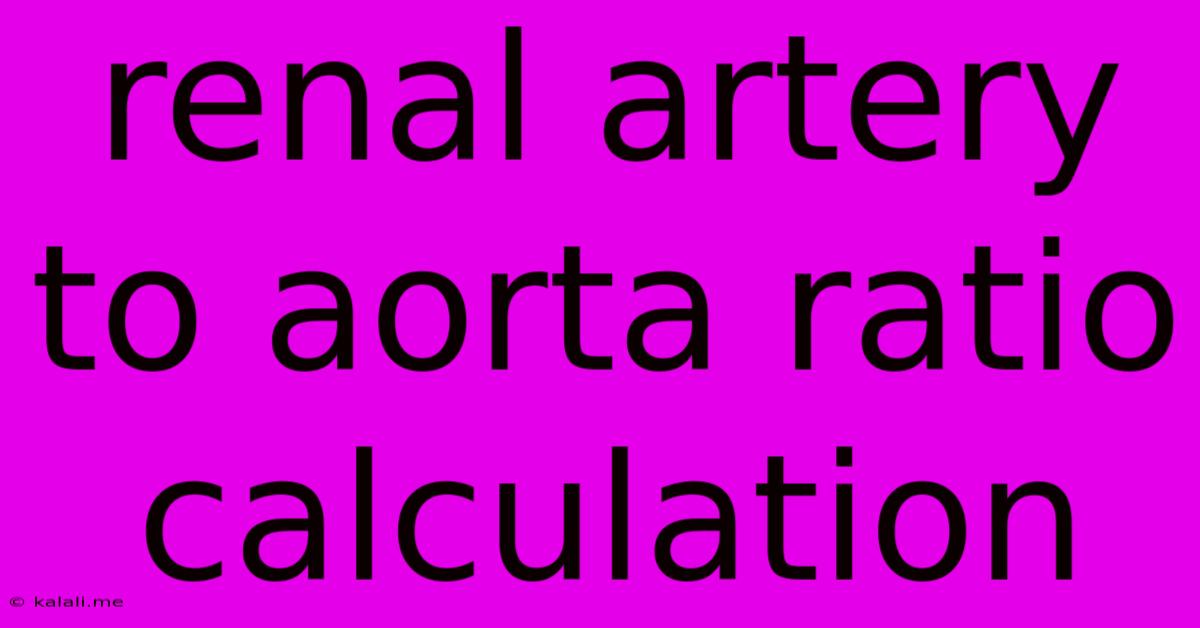Renal Artery To Aorta Ratio Calculation
Kalali
May 09, 2025 · 3 min read

Table of Contents
Renal Artery to Aorta Ratio (RAR): A Comprehensive Guide to Calculation and Interpretation
The renal artery to aorta ratio (RAR) is a non-invasive imaging technique used to assess renal artery stenosis (RAS). RAS, the narrowing of the renal arteries, can significantly reduce blood flow to the kidneys, impacting their function and potentially leading to hypertension and chronic kidney disease. Understanding RAR calculation and its clinical significance is crucial for accurate diagnosis and management of renal vascular disease. This article provides a comprehensive guide to RAR calculation and interpretation.
What is Renal Artery Stenosis (RAS)?
Before delving into RAR calculation, let's briefly define RAS. RAS occurs when one or both renal arteries become narrowed, restricting blood flow to the kidneys. This reduced blood flow can trigger the release of renin, a hormone that raises blood pressure, leading to hypertension. Over time, this can damage the kidneys, contributing to chronic kidney disease. Several factors can contribute to RAS, including atherosclerosis, fibromuscular dysplasia, and other vascular diseases.
How is RAR Calculated?
The RAR is calculated using Doppler ultrasound or computed tomography angiography (CTA). The process involves measuring the peak systolic velocity (PSV) of blood flow in the renal artery and the aorta. The formula is as follows:
RAR = Peak Systolic Velocity (PSV) in Renal Artery / Peak Systolic Velocity (PSV) in Aorta
- Peak Systolic Velocity (PSV) in Renal Artery: This measurement represents the highest velocity of blood flow within the renal artery during systole (the contraction phase of the heart).
- Peak Systolic Velocity (PSV) in Aorta: This measurement represents the highest velocity of blood flow within the abdominal aorta during systole.
Different imaging modalities may slightly alter the methodology for measuring PSV, but the underlying principle remains the same. Precise measurement is crucial for accurate RAR calculation.
Interpreting the RAR:
The interpretation of the RAR depends on several factors, including the patient's clinical presentation, other imaging findings, and the specific imaging technique used. However, a general guideline is as follows:
- RAR < 2.0: Generally considered normal and indicates minimal or no significant renal artery stenosis.
- RAR ≥ 2.0: Suggests possible renal artery stenosis. Further investigation may be required to confirm the diagnosis. The higher the RAR, the more significant the stenosis is likely to be.
- RAR ≥ 3.5: Often considered indicative of significant renal artery stenosis.
Limitations of RAR:
While RAR is a valuable tool, it's essential to acknowledge its limitations:
- False Positives: RAR can be elevated in the absence of significant stenosis, particularly in patients with increased cardiac output or other vascular abnormalities.
- False Negatives: RAR may not accurately detect stenosis in cases of ostial lesions (narrowing at the beginning of the renal artery) or significant calcification.
- Dependency on Imaging Quality: The accuracy of RAR calculation heavily relies on the quality of the ultrasound or CTA images. Suboptimal images can lead to inaccurate measurements and misinterpretations.
Beyond the RAR:
The RAR should not be used in isolation for diagnosing RAS. It should be interpreted in conjunction with the patient's clinical presentation, medical history, and other imaging findings. Additional tests, such as renal scintigraphy or magnetic resonance angiography (MRA), may be necessary to confirm the diagnosis and assess the severity of renal artery stenosis.
Conclusion:
The renal artery to aorta ratio is a valuable non-invasive tool for assessing renal artery stenosis. However, its interpretation requires careful consideration of various factors and should be combined with other clinical information to reach an accurate diagnosis. Always consult with a qualified healthcare professional for accurate interpretation and appropriate management of renal artery stenosis.
Latest Posts
Related Post
Thank you for visiting our website which covers about Renal Artery To Aorta Ratio Calculation . We hope the information provided has been useful to you. Feel free to contact us if you have any questions or need further assistance. See you next time and don't miss to bookmark.